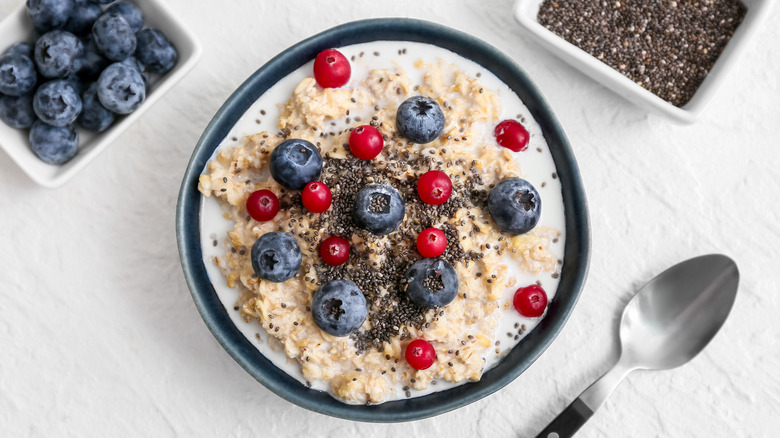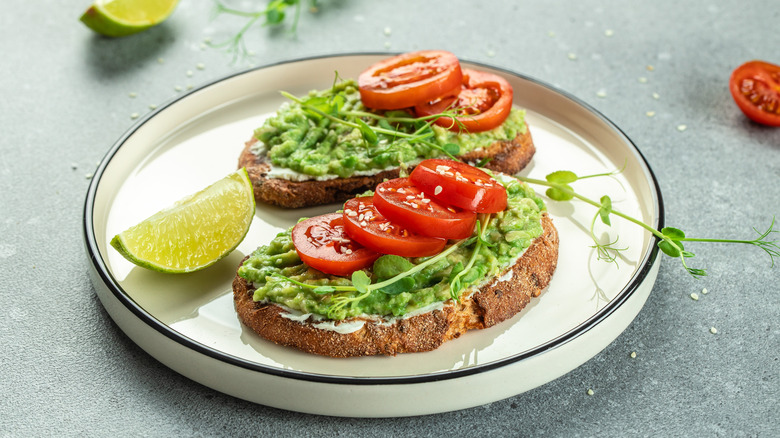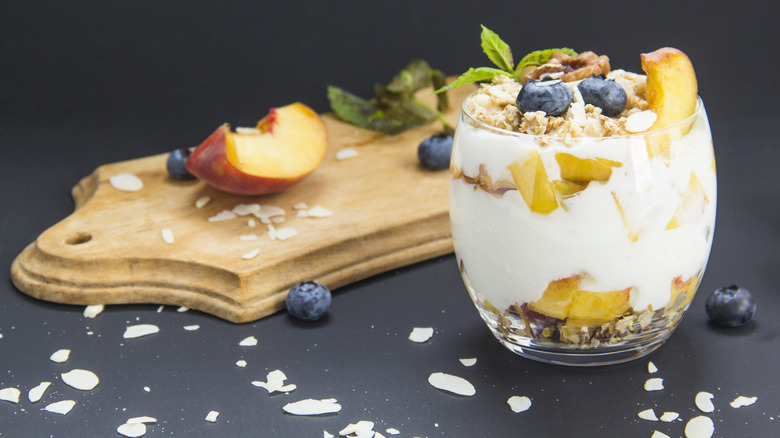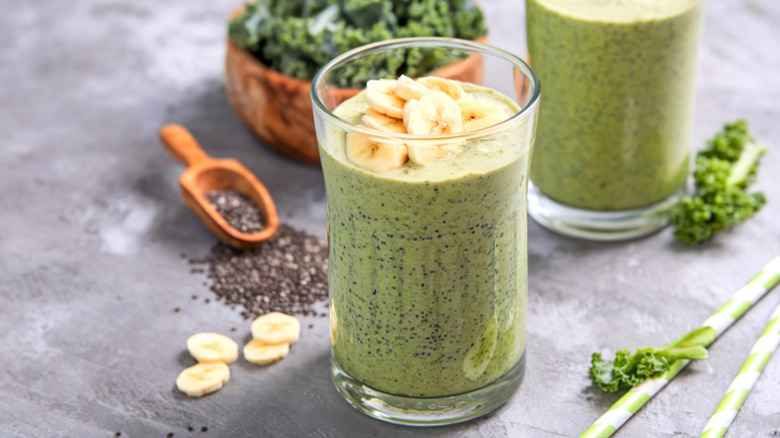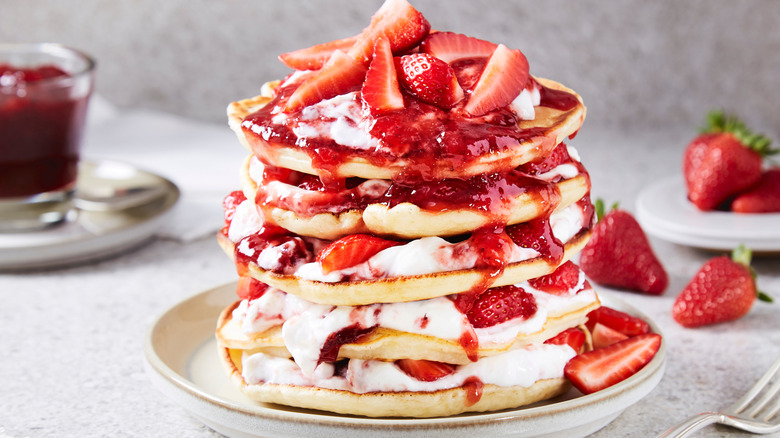10 Best Breakfasts To Lower High Blood Pressure (And Help With Healthy Weight Loss)
The term high blood pressure, or hypertension, refers to the pressure that your blood flow places on your blood vessels as it travels throughout your body. When that pressure is too high, it slowly damages your arteries, making it a silent but serious condition that affects millions of people worldwide and roughly half of the American population, per the National Heart, Lung, and Blood Institute (NHLBI). Hypertension often develops without noticeable symptoms. Yet, it can have detrimental effects on your health, including increasing the risk of heart disease, stroke, and kidney problems, which is why it earned the nickname "the silent killer." While genetics and age play a role in developing high blood pressure, lifestyle choices, especially diet, are key contributors. In fact, according to a 2010 review in The Annual Review of Nutrition, what you eat can either help keep your blood pressure in check or push it into dangerous territory. Thus, unsurprisingly, following a heart-healthy diet is among the recommendations for people looking to manage their blood pressure.
That being said, having a heart-healthy breakfast can set the tone for stable blood pressure throughout the day while also supporting healthy weight management, which is another vital factor in controlling hypertension. According to the American Heart Association (AHA), a diet that substitutes unhealthy saturated fats for healthier unsaturated ones and that's rich in fiber from fruits, vegetables, and whole grains is one of the best ways to take care of your heart. Nutrients such as nitrates might also provide beneficial effects. This article explores ten nutrient-rich breakfast ideas to support both better blood pressure and a healthier weight.
Oatmeal with berries and chia seeds
A warm bowl of oatmeal mixed with chia seeds and topped with fresh berries is comforting and a powerhouse breakfast for anyone looking to lower high blood pressure and support a healthy weight. Starting with oats' heart-friendly effects, a 2011 article in the Journal of Nutrition and Metabolism explains that this whole grain is a rich source of beta-glucan, a type of soluble fiber that helps with blood pressure control by improving insulin resistance and reducing blood cholesterol levels, two mechanisms that contribute to hypertension. Plus, it also helps control appetite, leading to a decreased food intake that might result in weight loss.
Moreover, with their high fiber and omega-3 fatty acid content, adding chia seeds to the mix may further support your heart goals, seeing that eating these tiny but mighty seeds has been linked to reduced blood pressure (via Healthline). In fact, a 2025 review in Clinical Therapeutics determined that chia seed intake significantly lowered systolic and diastolic blood pressure (the top and bottom numbers of the reading). Lastly, berries (such as blueberries, strawberries, or raspberries) not only deliver a flavor boost but also provide antioxidants to the recipe, which, per a 2022 review in Nutrients, improve blood pressure by reducing vascular stiffness, thus enhancing blood vessel function. Therefore, this recipe is not only extraordinarily nutritious and highly customizable, but it is also very easy to prepare. You may even make it ahead as a heart-healthy version of your preferred overnight oats recipe and warm it to enjoy it the following day.
Avocado toast on whole-grain bread
While it seems like the avocado toast craze is a thing of the past, you should hold on to this trendy recipe if you want to support your heart and weight. This is because, unlike most dietary fads and trends, the mix of ingredients in one might actually be good for you. On the one hand, avocados are a rich source of potassium, a mineral that helps balance the effects of sodium in the body and supports healthy blood pressure levels. It is also high in monounsaturated fats and antioxidants, which, according to a 2017 review in Nutrients, can help reduce cholesterol levels and support proper vascular function. Lastly, while avocado's fiber content might be one of its lesser-known nutritional attributes, research has linked it to improved weight outcomes.
On the other hand, due to its low-processing nature, whole-grain bread delivers a solid dose of nutrients, such as dietary fiber, potassium, magnesium, folate, iron, and selenium, which participate in numerous mechanisms that might lower your blood pressure readings, as well as help you shed some weight by contributing to a longer-lasting feeling of fullness. In fact, evidence suggests that eating up to three servings of whole-grain foods per day might be as effective for blood pressure control as taking blood pressure-reducing medications (via Medical News Today). While enjoying this breakfast can be a satisfying way to start your day with nutrients that nourish your heart, be sure to avoid adding heavily salted toppings, which can undo the benefits of this heart-healthy meal.
Greek yogurt parfait with nuts and fruit
Looking for a quick and easy breakfast to take on the go that also supports a heart-healthy lifestyle? Well, look no more, since a Greek yogurt parfait layered with fresh fruit and a handful of nuts is not just a delicious treat; it's also a strategic breakfast for lowering high blood pressure. Starting with the recipe's main ingredient, Greek yogurt is known for its higher protein content than regular yogurt, which helps increase satiety and boosts your metabolism, both important for effective weight management. Plus, being a fermented dairy product, it also contains probiotics (the beneficial bacteria that promote a healthy gut microbiome). According to a 2013 study in the British Journal of Nutrition, those who consumed dairy-derived probiotics significantly reduced their blood pressure readings. However, be sure to choose a plain, unsweetened variety when shopping for Greek yogurt to avoid excess sugar, which can contribute to weight gain and elevated blood pressure.
Moving on to the recipe's toppings, a 2010 study in Clinical Nutrition shares that, besides providing a crunchy texture, nuts are packed with healthy fats, magnesium, and potassium while keeping a low sodium count, all of which have verified beneficial effects for blood pressure control. Lastly, adding fruit introduces natural sweetness while increasing the breakfast's content of heart-healthy minerals. In fact, since fruits are also good sources of potassium and magnesium while packing their fair share of fiber, they are central to the DASH (Dietary Approaches to Stop Hypertension) eating plan, a dietary approach explicitly designed for people with hypertension (via the NHLBI).
Spinach and mushroom egg white omelet
Egg white omelets are a popular weight-loss-friendly breakfast idea due to the lower fat count you get by ditching the yolks. However, did you also know that it can also deliver powerful benefits for blood pressure control? Evidence suggests that egg whites contain a specific protein called RVPSL, which may have a natural blood pressure–lowering effect similar to how some medications work by helping blood vessels relax (via Science Daily). Plus, adding spinach and mushrooms to this breakfast might be just what you need to boost its heart-healthy effects.
On the one hand, a 2015 study in Clinical Nutrition Research shares that spinach is one of the highest dietary sources of nitrates, a compound that your body converts to nitric oxide (NO), which helps lower blood pressure by relaxing blood vessels. On a similar note, research shows that some mushrooms, like shiitake, reishi, and maitake, might also provide blood pressure-reducing properties through mechanisms that also lead to the relaxation of blood vessels, meaning that your blood flow won't have to put so much pressure on them as it passes by (via Springer Nature). Plus, both spinach and mushrooms provide ample fiber content while keeping a low calorie count, supporting weight control. Pair this omelet with a slice of whole-grain toast for a nutritionally balanced and heart-smart breakfast.
Kale smoothie with banana and flax seeds
A kale smoothie blended with banana and flax seeds is a refreshing breakfast with a serious nutritional punch. This green blend is quick to prepare, convenient to take on the go, and ideal for supporting healthy blood pressure and weight loss. At the core of this smoothie is kale, a nutrient-dense cruciferous vegetable packed with antioxidants, fiber, and minerals. However, its cruciferous vegetable status grants it most of its blood pressure-lowering benefits, seeing that, according to Medical News Today, one study linked a higher intake of cruciferous vegetables with reduced systolic blood pressure (the top number of the reading).
As for its banana content, it helps you get those natural sugars in, along with a generous amount of potassium. To be precise, adding a medium-sized banana to your smoothie might cover 11% of the daily potassium needs for men and up to 16% for women (via the AHA). In addition, the site adds that this fruit is a good source of fiber, making sure this smoothie keeps you feeling full for longer. And last but definitely not least, flax seeds act like the cherry-on-top ingredient in the recipe. These small seeds are rich in omega-3 fatty acids, particularly alpha-linolenic acid (ALA). Per a 2014 study in the American Heart Association Journal, higher ALA levels in the blood were linked to lower blood pressure readings. Plus, they're also high in fiber, which helps promote fullness, support digestion, and aid in weight loss.
Quinoa breakfast bowl with berries and almond butter
You might think quinoa is a grain reserved for lunch or dinner recipes, but have you ever tried a warm and cozy quinoa bowl for breakfast? If not, this recipe might surprise you and your heart in the best ways. On the one hand, quinoa has been linked to positive effects on heart health. According to a 2024 review in Frontiers in Nutrition, this ancient grain might help lower blood pressure by inhibiting an enzyme that tightens blood vessels and increases the amount of fluid in your blood, leading to higher blood pressure. Moreover, it contains all nine essential amino acids your body needs, making it a complete protein. As a whole grain, it also provides plenty of fiber. Together, this combination of protein and fiber makes it a powerful ally for weight loss (via the AHA).
On the other hand, berries bring a touch of freshness and a lot of antioxidants, notably polyphenols, to the mix, which have been linked to blood pressure-enhancing effects. For example, according to a 2022 review in Nutrients, when analyzing results from more than 120 studies with over 5,500 participants, berries were found to reduce both systolic and diastolic blood pressure significantly. Finally, topping your bowl with almond butter adds a creamy texture and monounsaturated fats, which are known for their beneficial effects on heart health. To make the bowl, cook quinoa in water or plant-based milk, then top with a mix of fresh or frozen berries and a spoonful of natural almond butter.
Tofu scramble with turmeric and vegetables
A tofu scramble with turmeric and colorful vegetables is a flavorful, plant-based breakfast option that provides an alternative to traditional scrambled eggs while still boosting your heart health. In fact, according to the AHA, adding 20 grams of plant-based proteins like tofu to your diet can lower your risk of hypertension by up to 16%. Moreover, evidence has linked soy-based foods like tofu to lower blood pressure thanks to their high content of a group of compounds called isoflavones, which, by increasing NO levels, may improve the elasticity of blood vessels (via Science Daily).
Furthermore, adding turmeric to the scramble provides more than just a beautiful golden hue to the recipe. According to a 2022 article in Frontiers in Physiology, curcumin, the active compound in turmeric, has been shown to help lower blood pressure through multiple mechanisms of action, including helping blood vessels relax, preventing blood vessels from becoming narrow or stiff, improving the function of the endothelium (the lining of blood vessels), and inhibiting your body's hormone system that raises blood pressure. Finally, adding a variety of vegetables, such as spinach, bell peppers, or tomatoes, not only enhances flavor and texture but also boosts the dish with fiber, antioxidants, vitamins, and minerals, all of which contribute to blood pressure regulation and overall health. To make a tofu scramble, simply crumble firm tofu in a skillet with olive oil, sauté with turmeric and your choice of vegetables, and season to taste.
Buckwheat pancakes with strawberries and yogurt
Want to indulge in a stack of pancakes for breakfast but don't want to compromise your heart health goals? Then, you might want to give these buckwheat pancakes topped with fresh strawberries and a dollop of yogurt a try. Despite its name, buckwheat isn't wheat at all. It is a gluten-free seed packed with nutrients that support cardiovascular health. The seed's rutin (a type of antioxidant), magnesium, and fiber content are some of the key nutrients behind its blood pressure-lowering effects.
Regarding the pancakes' toppings, adding strawberries might be a clever way to sweeten up the recipe while still supporting a healthy blood pressure, seeing that eating more strawberries (i.e., consuming half a cup at least three times per week) has been linked to a 34% risk reduction in heart attacks, likely due to the fruit's high anthocyanin content, which might reduce blood pressure by helping blood vessels relax (via Harvard Health Publishing). Lastly, topping it off with a fermented dairy product like yogurt adds probiotics, calcium, magnesium, and potassium, which, per a 2022 study in the International Dairy Journal, have a positive effect on blood pressure.
Breakfast wrap with hummus and veggies
A breakfast wrap filled with hummus and fresh vegetables is a savory, satisfying, and nutrient-packed way to start your day and care for your heart health, especially on those busy mornings when you need something easy to prepare and take on the go. The effects of this breakfast's blood pressure management are derived from all of its ingredients. For starters, hummus, made primarily from chickpeas (garbanzo beans), is an excellent source of plant-based protein, fiber, potassium, and magnesium, all of which play a key role in managing blood pressure while keeping your appetite and weight in check.
Moreover, adding a colorful mix of fresh vegetables like spinach, bell peppers, cucumbers, or carrots adds crunch, flavor, and an extra amount of potassium, fiber, and magnesium, three nutrients the DASH diet values and relies on for reducing high blood pressure (via the NHLBI). Lastly, wrapping it all up in a whole-grain tortilla (the DASH diet's preferred type of grain) is a foolproof way to add even more fiber and support steady energy levels throughout the morning. To assemble the wrap, spread a generous layer of hummus on top of the tortilla, load it up with veggies, and season with herbs, lemon juice, or a sprinkle of seeds for extra texture before wrapping it all together.
Beetroot juice smoothie with banana and yogurt
A beetroot juice smoothie blended with banana and yogurt offers a vibrant, refreshing, and highly effective breakfast option for lowering blood pressure, as each component brings unique benefits that work together to support your heart and keep you feeling full and energized. For example, beetroot juice is a well-researched ingredient for blood pressure reduction, thanks to its high content of dietary nitrates, which help regulate blood flow by relaxing blood vessels. In fact, according to a 2024 review in Nutrition, Metabolism, and Cardiovascular Diseases, beetroot juice was linked to lower systolic blood pressure (the top number of the reading) in adults with hypertension.
Plus, adding bananas to the mix not only helps with the smoothie's creamy texture and sweeter flavor but also contributes plenty of potassium and magnesium, two essential minerals for blood pressure control. Meanwhile, low-fat plain or Greek yogurt adds even more creaminess with a good amount of protein, probiotics, and even more of those heart-healthy minerals. While protein promotes satiety and helps control appetite throughout the morning, a 2021 study in the International Dairy Journal adds that the remaining nutrients, both individually and combined, support healthy blood pressure through multiple mechanisms of action. Preparing this smoothie is quite easy. Simply blend all three ingredients with a few ice cubes, and you're good to go!

